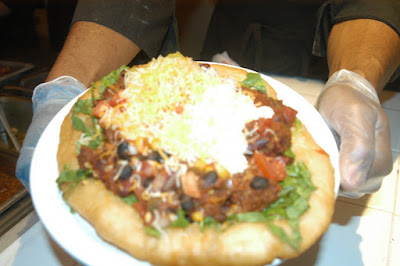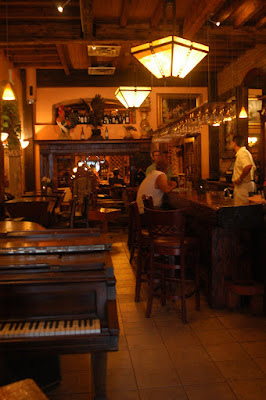
The reason for today's trip was prompted by a comment by my next-door neighbor, Jessie, who gave me many great ideas of places and things to see on our unplanned trek. Thanks, Jessie, for this one!
We spent ALL of today in Mesa Verde National Park (in southwestern Colorado near Cortez). This park consists of nearly 5,000 archeological sites including 600 cliff dwellings. Scores of large canyons seam the mesa -- and in the alcoves eroded in the cliffs are some of the world's largest and best preserved cliff dwellings. (Do you feel as though you are in history class? I was six hours short of a double major in English and history in college. I LOVE learning the stories behind events.) This park established in 1906 by President Theodore Roosevelt was the first national park of its kind. The park administers the preservation of archeological sites and other works and relics of the Ancestral Puebloan people. In 1978, Mesa Verde received international recognition as both a World Heritage Site and Biosphere Reserve. The Rangers told us that often there are more Europeans at the park than English-speaking people.
With over 53,000 acres, Mesa Verde preserves and protects over 4,500 archeological sites,including 600 cliff dwellings -- and over 3 million associated objects in the research collection. These sites are some of the most notable and best preserved in the United States.
The drive to the park from Durango (our current base) wound between and around high foothills to the peaks in the background.
 After driving all the switchbacks over three mountains recently, this was relaxing. Coming around a curve, Mesa Verde was unmistakable. Now this is a major mesa. In fact, there are two primary mesas associated with this National Park.
After driving all the switchbacks over three mountains recently, this was relaxing. Coming around a curve, Mesa Verde was unmistakable. Now this is a major mesa. In fact, there are two primary mesas associated with this National Park. From the park's entrance (where we once again were able to "flash" our Senior Lifetime Pass to all National Parks -- that's ALL we're flashing these days!), we climbed 15 miles to the Visitor's Center. As I've stated previously, there are just no more superlatives to describe the vistas we see around every turn.
 YOU must come and see them one day!
YOU must come and see them one day!Fortuitously, we were able to join a half-day bus trip with a park ranger. (This was a helpful thing since my friend is unable to walk any distance.) This was also a good decision because the ranger was informative, entertaining, and allowed us to see more than we would have on our own. (My neighbor had suggested that this was the best way to see the park initially.)
But first, we had lunch -- Navajo tacos. Ever heard of these? My friend has been talking about Indian tacos since we started our travels -- evidently, this is a "hot" seller in OKC. When we were in the Black Hills (SD), there were a few places offering Indian tacos. In all my culinary experiences in places around the globe, this was a new treat. Here are the differences in Indian tacos and the tacos we primarily know. First, fry bread instead of tortillas forms the basis of this dish. The fry bread is flat and the size of a plate! (If you don't know fry bread, watch one of my favorite Sherman Alexie movies called Smoke Signals -- they refer to this delicacy frequently.) Then a variety of toppings are artistically placed on the fry bread...chili or chicken, beans, shredded lettuce, cheese, onions, and the best jalapeno spread that looks for all the world like guacamole. There is no way one person could -- or should -- eat this entire creation. I meant to take a picture of my dish but remembered this task halfway through (when I stopped eating) so I went back to the kitchen and they let me photograph one they had just fixed.
 Unfortunately, the light was not good or the camera or the person tilting the plate moved so the picture is somewhat blurred...but you can get the idea. It was double yummo.
Unfortunately, the light was not good or the camera or the person tilting the plate moved so the picture is somewhat blurred...but you can get the idea. It was double yummo. Okay, here is your history info for the day. The earliest known inhabitants of Mesa Verde were the Modified Basket Makers, descendants of a people who lived in the Four corners region. They built subterranean pit houses about A.D. 500 - 750. From A.D. 750-1100, these cliff dwellers perfected their living quarters, building kivas (ceremonial or domestic rooms -- depending with whom you speak) and masonry houses around open courts (pueblos). From A.D. 1100 - 1300, arts and crafts reached their peak; pottery and cloth were often elaborately decorated. Around 1200, these people moved into the alcoves for reasons that remain unknown and built cliff dwellings. Sometime about 1276 a drought struck and lasted 24 years. The resulting crop failures, depletion of resources, other environmental problems, and possible conflicts may have driven the people from Mesa Verde in search of a more reliable water supply and improved living conditions.
Some of the Pueblo people living in the Rio Grande pueblos in northwestern New Mexico and on the Hopi mesas in Northern Arizona are descendants of the former occupants of Mesa Verde. After ALL the painstaking work, the people who built these cliff dwellings only lived in them for 100 years. That would entail two to three generations since women averaged a life span of 24 years and men often made it to 40 years. These people were little with men standing 5'4" and the women only 5' in height.
From our history books, I always had the impression that these cliff dwellers lived in these dwellings for thousands of years. Not true. Only the last 100 years (they lived in his area!) as previously stated. Their pit houses gave rise in later years to a series of better housing. We were fortunate to visit several of these sights up close and personal.
Looking across the canyon with Ranger Tim as our guide, you can see the Cliff Palace, one of the most photographed of the cliff dwelling.
 (When we got on the bus, we didn't realize that we would also get to go into the Cliff Palace.) Reaching the actual site of the Cliff Palace involves descending uneven stone steps and climbing five ladders for a 100 ft (30M) vertical climb.
(When we got on the bus, we didn't realize that we would also get to go into the Cliff Palace.) Reaching the actual site of the Cliff Palace involves descending uneven stone steps and climbing five ladders for a 100 ft (30M) vertical climb.  I know that these don't even appear real but this is the actual Cliff Palace exterior. According to Ranger Tim, there were 21 families living here "condo" style -- each family built their home in their own style...and you can see this up close. Additionally, this complex consisting of over 150 rooms extends 90 feet into this rock area.
I know that these don't even appear real but this is the actual Cliff Palace exterior. According to Ranger Tim, there were 21 families living here "condo" style -- each family built their home in their own style...and you can see this up close. Additionally, this complex consisting of over 150 rooms extends 90 feet into this rock area.  It was difficult to get my head around the kind of hardships these folks faced. They were farmers primarily after their basket period planting corn, beans, and squash together -- the Indians call these vegetables the "three sisters." Did you know that they planted the corn the beans, and the squash in the same hole? The corn provided a stalk for the beans and the squash provided shade to hold in the moisture around the plants. Very clever.
It was difficult to get my head around the kind of hardships these folks faced. They were farmers primarily after their basket period planting corn, beans, and squash together -- the Indians call these vegetables the "three sisters." Did you know that they planted the corn the beans, and the squash in the same hole? The corn provided a stalk for the beans and the squash provided shade to hold in the moisture around the plants. Very clever.We also got to see Spruce Tree House, the best preserved of the cliff dwellings.

We left this area enriched and educated.
Ah, so it was getting towards supper time by the time we left the park. Yesterday while we were cruisin' the Main Street of Durango, we passed Jean-Pierre's French (of course!) Bakery and Restaurant. Decided that would be our final stop for the day. We were not disappointed. Again, it was a lovely restaurant wth an eclectic but elegant feel. The food matched the ambiance.
 I had French Onion Soup and Escargot (not exactly a balanced diet but very tasty -- and not as delectable as my favorite little French bistro Le Bonne Soupe in NYC) and my friend had trout flown in from Pike's Market in Seattle. (Wonder why they didn't have locals supplying the fish?) Great service and food. Highly recommend when you are in town. :-)
I had French Onion Soup and Escargot (not exactly a balanced diet but very tasty -- and not as delectable as my favorite little French bistro Le Bonne Soupe in NYC) and my friend had trout flown in from Pike's Market in Seattle. (Wonder why they didn't have locals supplying the fish?) Great service and food. Highly recommend when you are in town. :-)I'm hoping that we will be heading towards OKC tomorrow. This has been a fun trip but all good things must come to an end. Probably will do ONE or TWO more blog entries...just depends. Thanks for hangin' in there with us on our Crazy Horse and more adventures.
















Where are the photos of Thelma and Louise? Absolutely gorgeous scenery photos but what about the human elemant? We want to see you all!Glad you are having a safe and educational journey! Stacey
ReplyDelete